There's no place like home and no good promo email with plain text.
If sometimes, you struggle with emails because of the text part (like I struggle with proverbs). In this article, we will tell you about embedded images' benefits and show you some interesting email examples.
Benefits of using images for emails
Emails with high image quality are easier to digest
To see what we mean, compare these two versions of one email:

(Source: Email from Coursera, with images)

(Source: Email from Coursera, plain-text)
The difference is obvious – embedding images makes it much easier to comprehend any information.
According to research, our brain is hooked up on visual content – with visuals, we process information 60 000 times faster than with conventional text. No wonder our ancestors used to communicate with drawings on the cave walls.
It works the same way in email marketing. A photo or any other visual in an email helps us process information faster and determine its value easier.
Images make a great impact on brand identity
When Google acquired YouTube, it also re-branded all of YouTube’s email marketing campaigns to fit Google’s brand. You can notice a similar design and style of images in Google’s and YouTube’s latest marketing emails:
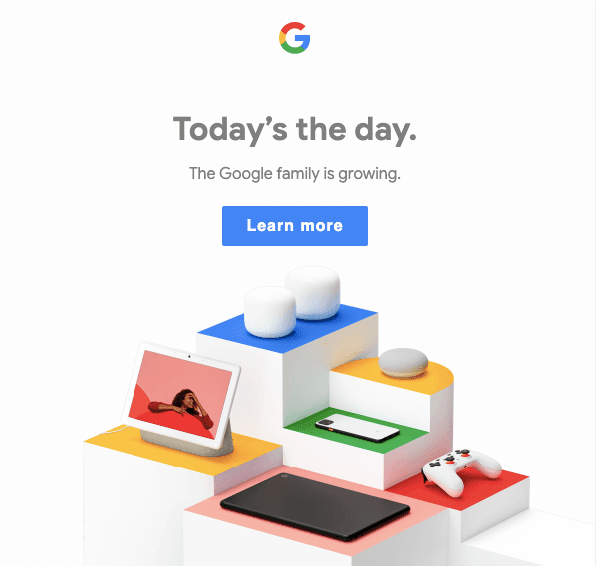
(Source: Really Good Emails)
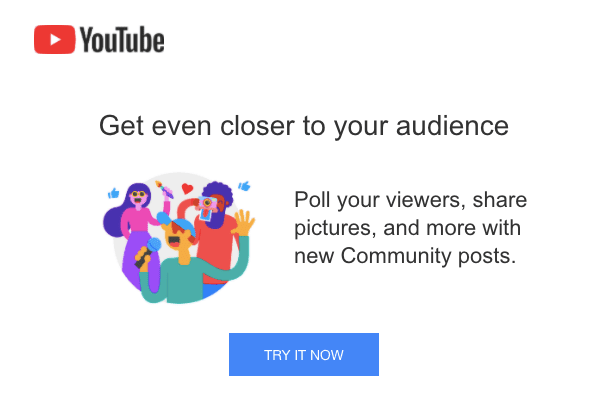
(Source: Really Good Emails)
In these examples, you can see that Google uses the same approach to the font and the visuals in YouTube’s emails, thus building its brand as a part of Google.
Such an approach serves well to make your brand's online presence more consistent, which, in turn, can increase your revenue by up to 33% and significantly improve your brand recognition.
Visuals in emails improve engagement rates
The primary goal of a marketing email is to improve click-through rates and increase conversions. But can a plain text email achieve these goals?
If you go back and look at our visual vs. plain text example, you will confirm that an easy-to-digest copy is more engaging than cramped and unreadable text.
HubSpot’s 2020 research confirms this statement: over 20% of surveyed marketers stated that proper brand-oriented email design significantly helps improve their email engagement.
So, while images may not have worked for Impact BND, they are working quite well for many other brands, especially B2C companies, which vastly use visuals to promote their products via email marketing.
Types of images for email
The sky is the limit regarding the types of images you can include in your marketing emails. But let’s look at a few examples that you might find inspiring and fitting for your email marketing campaign, along with a few images of email examples.
Black and white
This type of imagery might not be your first choice for email marketing, as you’d be more tempted to include something more colorful.
However, the black and white design of an image can help you achieve a certain purpose, as it has a few significant benefits:
-
it eliminates distractions. While every element in a colored photo usually draws attention to itself, resulting in distorted perception, the black and white design helps perceive the image as a whole. As a result, it communicates your message more clearly;
-
monochromatic imagery adds to a certain emotion. Depending on the mood of your email, the black and white design can make it seem more intense;
-
subtle tones promote minimalism. If you want to focus your marketing email on a certain message, the black and white design is the best choice because it’s minimal and subtle.
If you want to see all these three benefits in action, take a look at this email from Everlane:
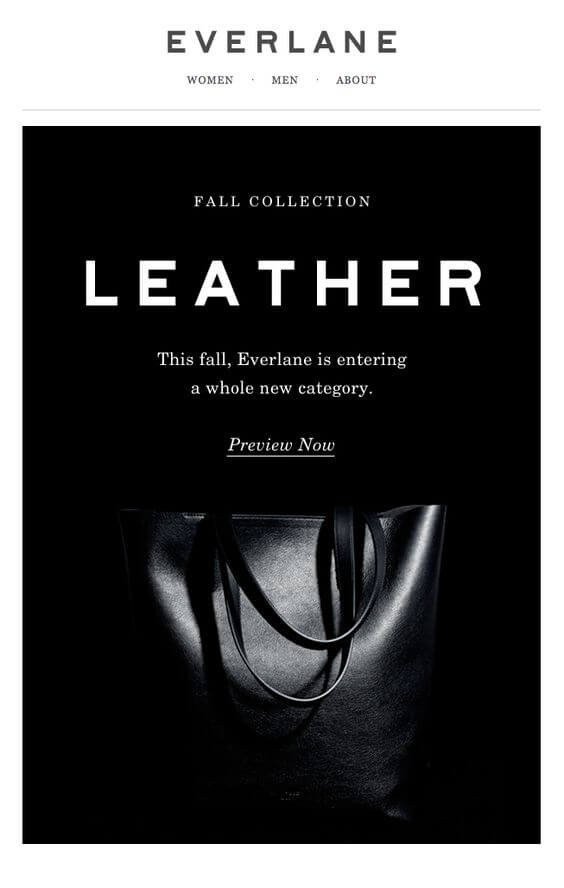
(Source: Email from Everlane)
Please find more examples in our Black and White Emails blog post.
GIFs
This type of imagery became a popular addition to emails long ago. Many brands have built up their email marketing campaigns using GIFs, and they were quite right.
Indeed, if you see an email containing a GIF, it instantly engages you and puts you in the right mood. Take a look at this marketing email from Chubbies:
(Source: Email from Chubbies)
A GIF, in combination with the right message, can be a powerful marketing tool, which you can see from the example above.
But why do people like GIFs so much?
According to the research published by Sage Journals, people prefer GIFs because they create a so-called “networked effect,” meaning that a GIF initiates a quick interaction between a brand and a customer. And you know how much customers love being a part of a brand.
GIFs, however, are not universal and don’t fit into every marketing email. So, make sure the images in the email are in line with the purpose of the message.
Banners
Brands often choose banners among other email images if they need to notify a customer about an upcoming promotion or some other news regarding sales.
Banners are a good choice for such purposes because they drive attention directly to the promotion you’re trying to market. You can see how it works in the following email example:
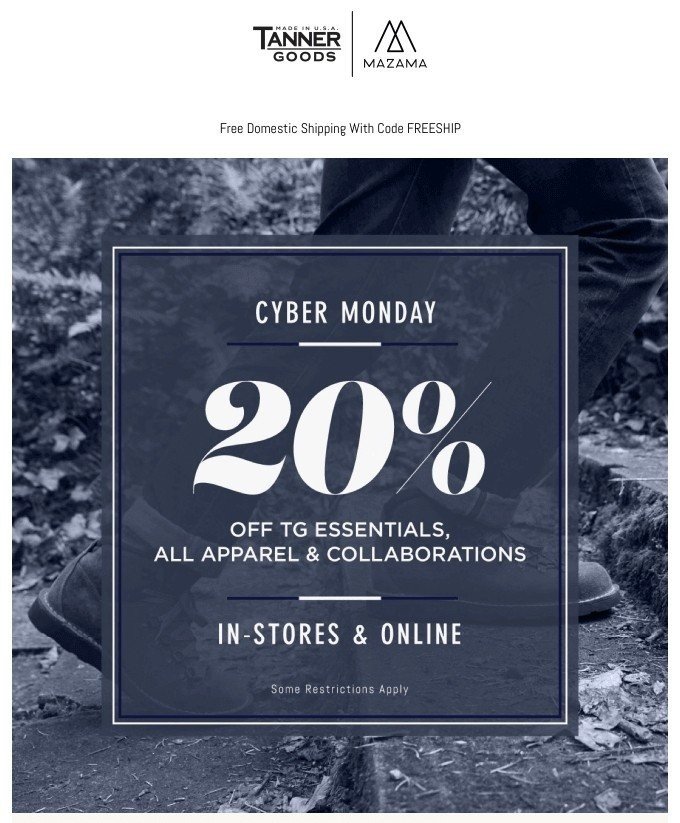
(Source: Email from Tanner Goods)
However, banners work well for promotions, company newsletters, and other notification-type emails. In this case, banners can include either a company logo or a relevant image or can be used to highlight the message. Please watch our video to learn more about types of banners and ways of building them:

3D Images
A great way to diversify the imagery in your marketing emails is by including 3D images. They are 2D images, but the 3D effect is achieved by combining a single-color background and the dynamics of other elements in the picture.
You can see how it works in Hulu’s email below:

(Source: Email from Hulu)
As you can see, the black background contrasts with red, grey, and white in the photo, creating a 3D effect.
You can also use 3D images in an email to demonstrate a product and highlight its main features. Make sure you use a white background so that other elements in a photo don’t clash with it.
Infographics
This type of email marketing image fits well if your purpose is to brief your customers on something that usually involves numbers. It can be the results of a survey, poll, performance round-up, etc.
For instance, in the email below, you can see how CloudApp uses an infographic to notify a customer about the performance of their cloud storage:
.jpg)
(Source: Email from Central)
The use of infographics in your marketing emails promises you good performance. According to Venngage, people are 30 times more likely to read infographics from top to bottom than plain text.
As you can see, users are interested in this type of content mainly because it is educational and delivers immediate value. That’s why it can be a good addition to your marketing emails.
Background images
Background images in email deliver no message. However, they do complete the entire design idea. Such images could be bright, pastel — no matter. But they ought to have no certain ornament on them as background images are often cycled/repeated in emails. And you never know when it stops and starts again in a user’s inbox. So, in order to make the background seamless, please avoid using images with distinct ornament.
Requirements for the email marketing images
Now, as we’ve covered the benefits and the basic types of email marketing images, let’s discuss the requirements for including imagery in your emails.
Image formats
There are three main image formats that you can use to save email images – JPEG, GIF, and PNG. Let’s talk a bit about the differences between these three formats.
-
JPEG images – you can use this format if you want your imagery to retain color, but you should keep in mind that JPEG format will shrink your image, reducing its quality significantly;
-
GIF images – this format works great if your email provider doesn’t allow including videos, and you still need to include some action in your email. The significant drawback of GIF format is that it doesn’t show colors as vividly as the JPEG format would;
-
PNG images – if you need to effectively place a photograph with sharp edges, include a logo or a visual with a transparent background; this format should be your first choice. The PNG format also retains the quality of an image regardless of its size and color saturation.
Keep in mind that if you include heavy PNG images, it will also increase the size of your email, affecting its loading time.
Color profile
The color profile of email images differs from those that go for print.
When working on imagery for your marketing emails, make sure that you save them with the RGB color mode. Compared to the CMYK color profile used for printed images, RGB color mode uses red, green, and blue to create a wide diversity of colors to show them correctly in digital mode, but it doesn’t work for print.
Image file size
As we already mentioned, including heavy images in your emails can negatively impact their loading time or distort how the image appears on the screen.
We recommend including email images with a maximum size of 1MB and 72 DPI on average. This size of image files is enough to appear correctly in the digital format and won’t distort the quality of your overall email design.
Image size
To ensure that all images show correctly on your email template, use email images with a width of 600 pixels if your email is of the standard width.
Did you know that you can set your custom width with Stripo:
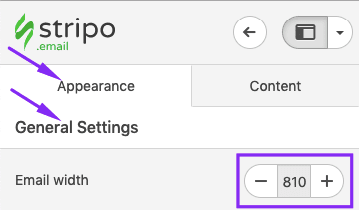
Of course, the size of your image files will also depend on the design and format, the number of background images in the email, and the number of columns. For instance:
-
564-pixel images are recommended for full-width sections;
-
264-pixel imagery works well for 2-column designs;
-
164-pixel images are perfect for 3-column email templates.
Remember what content you include in each block and indents between blocks of your email template because it will also impact the imagery size.
Please remember that you can resize, crop, and edit images with the Stripo embedded photo editor.
Alt text, aka alternative text
If your target audience has trouble loading the full version of your email or their email client like Outlook) uses email image blocking by default, you need to include alt text that will appear in the plain text version, or in case users block images, to comply with the Email accessibility rules.
When writing alt attributes for your images, make sure that:
-
the alt text is concise. Alt text doesn’t need to be wordy, but it should precisely describe what the image shows;
-
include keywords. Make sure the alt text has the main and a couple of additional keywords, but don’t overstuff it with too many keywords and phrases;
-
don’t mention the word ‘image.' The format of the imagery is enough to determine the type of content you’re describing in the alt text.
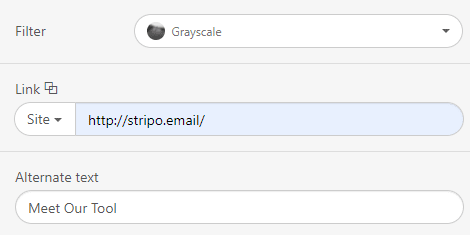
Using images in emails: Best practices
Now, as you know the types of email images, requirements, and tools to edit images, is it enough to craft high-quality email templates?
This knowledge is substantial to create great images for email, but we want to share some best practices to improve their performance.
1. Optimize images for mobile devices right away
Today, optimizing emails for mobile devices is no longer a choice, it’s a requirement.
To do it, you need to keep in mind a few important details:
-
the design of your template;
-
the number of columns;
-
the size of the image;
-
the format of the image.
Please be advised that with Stripo you do not need to design different images for desktop and mobile devices. You may just activate the "Responsive Image" option on:

Then your images will be fully responsive across all mobile devices. Just see examples below:
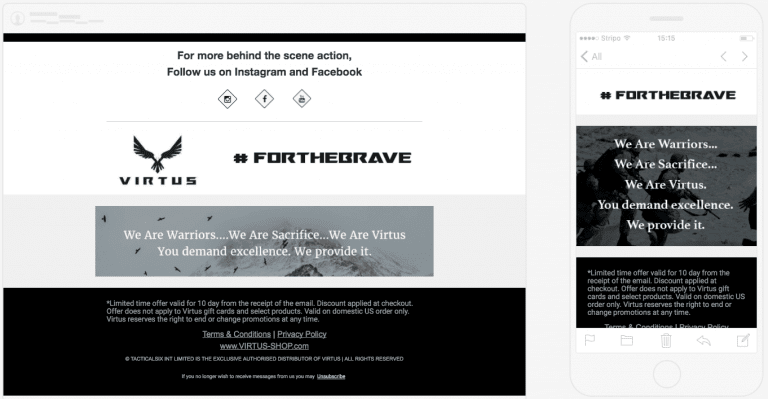
So, to make sure that your email images are displayed correctly, optimize them for mobile devices.
2. Use a combination of imagery and text
There is no doubt that emails with full-width images are the perfect match for marketing purposes. They are more engaging, interactive, and better showcase the product.
However, if your email only consists of images, there's a chance it will get blocked by email clients.
So, the best solution is to include images and text in your email. But remember that just as your images need editing, your text needs proofreading. You can automatically proofread the text for your emails using online editors from a thesis writing company of your choice.
In your templates, you can follow the 60:40 ratio:

Even if this message is plain text, the subscribers can still get a sense of the message from the text.
3. Target your audience with your choice of email images
We already mentioned the importance of your images in email for the recognition of your brand. But most importantly, the imagery that you choose for your emails directly represents who your audience is.
While this company presented below also has merchandise for men, from the images in its emails, you can see that they mostly cater to their female audience:
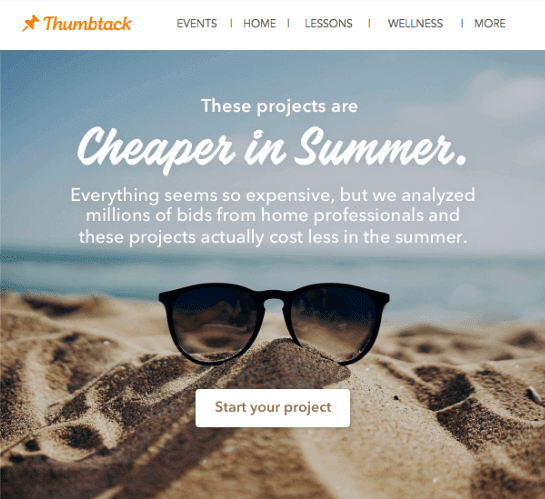
(Source: Email from Thumbtack)
That’s why, when crafting images for your email campaigns, consider your main audience and their preferences. Such an approach will also benefit the recognition of your brand.
4. Avoid stock images for your emails
Creating images for email can take a lot of time, especially if you want them to represent your brand in the best way possible.
That’s why it might be tempting to get a stock image and speed up the launch of your email marketing campaign.
However, using stock photos as your email images does not benefit your authority as a brand. Reportedly, only 23% of marketers say that stock photography does well for promotional purposes.
There are quite a few reasons why stock photos are not the best choice for email images:
-
it’s someone else’s vision. A stock photo cannot represent your brand’s identity, therefore harming your brand’s marketing efforts;
-
stock photos often lack originality. Such content often looks cliché and worn-out, which does not add credibility to your emails;
-
someone else might have already used them. There is a high chance that a subscriber has already seen the stock photo you’re using in another email, which only confuses their perception of your brand.
If you want your email marketing efforts to pay off, it is better to create original images that represent your brand and its values. Besides, you can always reuse your original images for other marketing purposes.
Final thoughts
The debate around the use of images in emails will probably never end. But what’s its purpose if enough evidence shows that images work great for email marketing strategy?
But if you want to make email images work for you, you must approach them wisely. Make sure you keep up with all the requirements, including image size, format, color mode, and alt text, and use editing and testing tools to check how your emails perform.
Also, don’t disregard the best practice tips we shared with you. They will help you create email images that align with your brand’s identity, which is very important if you want your marketing efforts to pay off.
And, if you’re unsure if using images in your emails will work for you, you can use Stripo’s ready-to-use templates and editor to map out your email template.






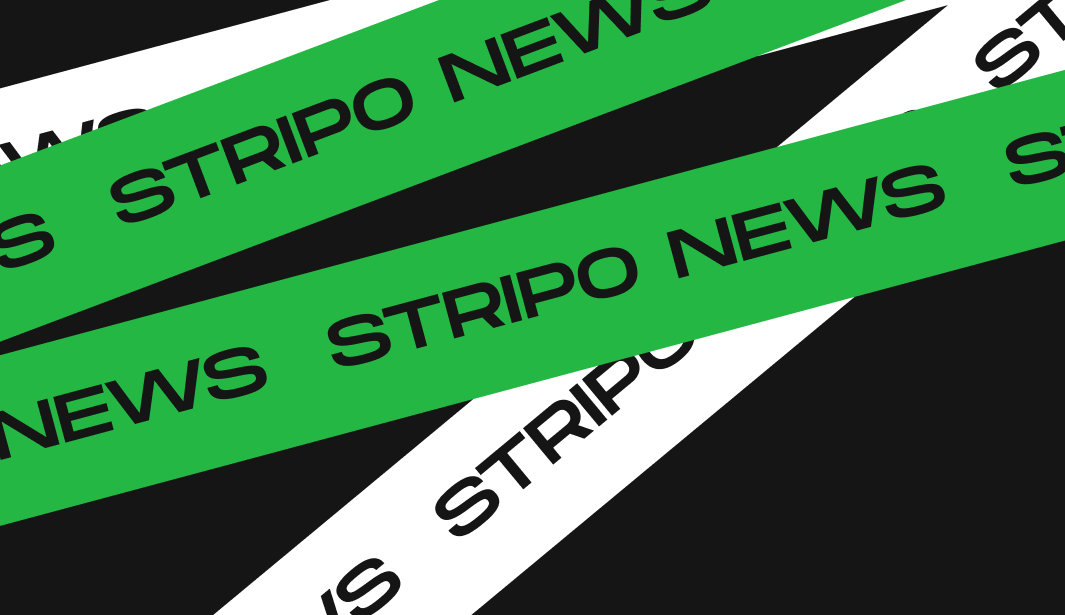


2 comments